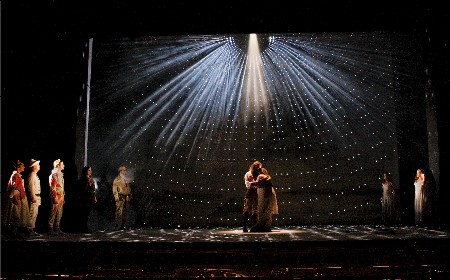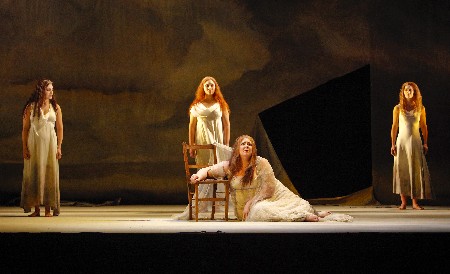Opera Review: ‘Ariadne auf Naxos’
Reviewed By Caldwell Titcomb

Ariadne auf Naxos: Bacchus (tenor Brandon Jovanovich) and Ariadne (soprano Marjorie Owens) share a transformative moment as the commedia dell’arte troupe and Ariadne’s nymphs watch in awe. Photo: Jeffrey Dunn
I was not able to catch Ariadne auf Naxos until the last of six performances that the Boston Lyric Opera (BLO) presented at the Shubert Theatre. By this time everything was clicking superbly—both the singers and the instrumentalists in the pit. What we got was a production that the BLO imported from the Welsh National Opera.
This work was one of several collaborations between composer Richard Strauss (1864-1949) and poet-librettist Hugo von Hofmannsthal (1874-1929). The idea at first was to follow a German version of Molière’s Le Bourgeois Gentilhomme with a half-hour Ariadne—in which form it had its premiere in 1912. It was agreed that this didn’t work. Back to their labors they went, and they came up in 1916 with a new, 40-minute Prologue followed by an 85-minute Ariadne as an opera-within-an-opera.
The Prologue presents a Composer (a breeches role for a soprano) who has written a serious work to be performed as after-dinner entertainment for a rich man’s guests in Vienna. The Composer is distraught upon learning that his work will preface a performance by a commedia dell’arte troupe consisting of Zerbinetta and four comical colleagues. The outlook grows even dimmer when it is decreed that the two performances take place simultaneously so that a fireworks display can begin as scheduled at 9:00.
The ensuing opera proper finds the Ariadne of mythology prostrate with grief on a deserted island, watched over by three nymphs. She yearns for the messenger of death. The comedians arrive and repeatedly try to cheer her up with lively song and dance, but Ariadne remains resolutely inconsolable. Eventually a man descends from the sky whom Ariadne assumes to be Hermes, the death messenger. But it is instead the god Bacchus. When she collapses on his breast, she senses a change wrought by the gods, and the pair discover a mutual love that will last as long as the heavenly stars.
Nothing inspired Strauss more than the soprano voice—in fact, his wife Pauline was a noted soprano. In Ariadne three of the four chief roles are sopranos. Edyta Kulczak brought fire to the role of the Composer, who gets to articulate a credo: “Music is a holy art . . . the most divine of the arts.” Boston University alumna Rachele Gilmore was fully up to the stratospheric coloratura demands of Zerbinetta. And Marjorie Owens’s Ariadne exhibited a huge voice of almost Wagnerian heft. Brandon Jovanovich proved a suitably heroic tenor as Bacchus.
The supporting roles were also in excellent hands—especially Jake Gardner’s harried Music Master, along with Julius Ahn, Jesse Blumberg, David M. Cushing, and Tracy Wise as Zerbinetta’s comics, and Joanna Mongiardo, Andrea Coleman, and Mara Bonde as the nymphs. The speaking role of the Major-Domo—which was inexplicably omitted from the printed program—was done with the proper officiousness by Will LeBow (on loan from the American Repertory Theater).

Ariadne (soprano Marjorie Owens) laments being stranded on the island of Naxos by her groom Theseus as her Nymphs (soprano Joanna Mongiardo, mezzo-soprano Andrea Coleman, soprano Mara Bonde) look on with pity. Photo: Jeffrey Dunn.
Set designer Dale Ferguson gave us a ramshackle backstage for the Prologue, with four dressing rooms and a long staircase, and, on the island, some torn and ripped flats, perhaps suggesting Ariadne’s sundered soul. At the end, when Bacchus refers to the everlasting stars, the side flats and the upstage curtain are raised to reveal a memorable wall of a thousand lights (thanks to lighting designer Tim Mitchell). Ferguson was also responsible for the highly varied costumes, at one point including a ukulele for the dancing master and a parasol and sunglasses for Zerbinetta.
Strauss was used to writing for orchestras of 100 or more. When using a modest orchestra of 37 persons for Ariadne, he almost gave up along the way. But he stuck to his intent and finally achieved a seriocomic masterpiece. Conductor Erik Nielsen got splendid playing from his charges.
Strauss had a special fondness for treating material from antiquity or mythology. Ariadne thus joins a number of other important works: Salome (1905), Elektra (1908), Josephslegende (1914), Die Frau ohne Schatten (1918), Die ägyptische Helena (1927), Daphne (1937), and Die Liebe der Danae (1940). He also composed some new music for Gluck’s Iphigénie en Tauride (1890).
Near the end of his life, Strauss famously remarked, “I may not be a first-rate composer, but I am a first-class second-rate composer.” He sold himself short. As Ariadne demonstrates, he was a superlative composer, and the BLO gave us a superlative show.
Tagged: Ariadne auf Naxos, Boston-Lyric-Opera, Caldwell-Titcomb, Classical Music, Opera
